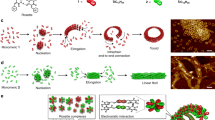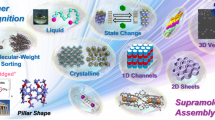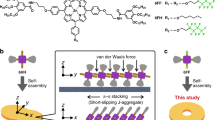Abstract
Precise control of supramolecular objects requires the rational design of molecular components, because the information determining their specific assembly should be encoded in their molecular architecture1,2,3,4. In this context, diverse self-assembling molecules including liquid crystals5, dendrimers6, block copolymers7, hydrogen-bonded complexes8 and rigid macrocycles9 are being created as a means of manipulating supramolecular structure. Incorporation of a stiff rod-like building block into an amphiphilic molecular architecture leads to another class of self-assembling molecules10. Aggregation of rod building blocks can generate various nanoscale objects including bundles11,12, ribbons13, tubules14,15 and vesicles16, depending on the molecular structure and/or the presence of a selective solvent. We present here an unusual example of supramolecular barrels in the solid and in aqueous solution, based on the self-assembly of amphiphilic rigid–flexible macrocycles driven by non-covalent interactions. Preliminary experiments show that these amphiphilic macrocycles are membrane-active. The amphiphilic macrocycles might thus lead to an excellent model system for exploring biological processes in supramolecular materials.
This is a preview of subscription content, access via your institution
Access options
Subscribe to this journal
Receive 12 print issues and online access
$259.00 per year
only $21.58 per issue
Buy this article
- Purchase on Springer Link
- Instant access to full article PDF
Prices may be subject to local taxes which are calculated during checkout




Similar content being viewed by others
References
Lehn, J.-M. Supramolecular chemistry and self-assembly special feature. Toward complex matter: supramolecular chemistry and self-organization. Proc. Natl Acad. Sci. USA 99, 4763–4768 (2002).
Whitesides, G. M. & Grzybowski, B. Self-assembly at all scales. Science 295, 2418–2421 (2002).
Sarikaya, M., Tamerler, C., Jen, A. K.-Y., Schulten, K. & Baneyx, F. Molecular biomimetics: nanotechnology through biology. Nature Mater. 2, 577–585 (2003).
Elemans, J. A. A. W., Rowan, A. E. & Nolte, R. J. M. Porosity of core–shell nanoparticles. J. Mater. Chem. 13, 2661–2666 (2004).
Kato, T. Self-assembly of phase-segregated liquid crystal structures. Science 295, 2414–2418 (2002).
Percec V. et al. Self-assembly of amphiphilic dendritic dipeptides into helical pores. Nature 430, 764–768 (2004).
Föster, S. & Plantenberg, T. From self-organizing polymers to nanohybrid and biomaterials. Angew. Chem. Int. Edn Engl. 41, 688–714 (2002).
Hirschberg, J. H. K. et al. Helical self-assembled polymers from cooperative stacking of hydrogen-bonded pairs. Nature 407, 167–170 (2000).
Zhao, D. & Moore, J. S. Shape-persistent arylene ethynyene macrocycles: syntheses and supramolecular chemistry. Chem. Commun. 7, 807–818 (2003).
Lee, M., Cho, B.-K. & Zin, W.-C. Supramolecular structures from rod–coil block copolymers. Chem. Rev. 101, 3869–3892 (2001).
Stupp, S. I. et al. Supramolecular materials: self-organized nanostructures. Science 276, 384–389 (1997).
Das, G. et al. β-Fibrillogenesis from rigid-rod β-barrels:hierarchical preorganization beyond microns. Angew. Chem. Int. Edn 40, 4657–4661 (2001).
Zubarev, E. R., Pralle, M. U., Sone, E. D. & Stupp, S. I. Self-assembly of dendron rod–coil molecules into nanoribbons. J. Am. Chem. Soc. 123, 4105–4106 (2001).
Park, S., Lim, J. -H., Chung, S.-W. & Mirkin, C. A. Self-assembly of mesoscopic metal-polymer amphiphiles. Science 303, 348–351 (2004).
Hill, J. P. et al. Self-assembled hexa-peri-hexabenzocoronene graphitic nanotube. Science 304, 1481–1483 (2004).
Vriezema, D. M. et al. Vesicles and polymerized vesicles from thiophene-containing rod–coil block copolymers. Angew. Chem. Int. Edn Engl. 42, 772–776 (2003).
Lee, M., Jang, C. J. & Ryu, J.-H. Supramolecular reactor from self-assembly of rod-coil molecule in aqueous environment. J. Am. Chem. Soc. 126, 8082–8083 (2004).
Fürstner, A. Olefin metathesis and beyond. Angew. Chem. Int. Edn Engl. 39, 3012–3043 (2000).
Schappacher, M. & Deffieux, A. α-Acetal-ω-bis(hydroxymethyl) heterodifunctional polystyrene: synthesis, characterization, and investigation of intramolecular end-to-end ring closure. Macromolecules 34, 5827–5832 (2001).
Wang, H., You, W., Jiang, P., Yu, L. & Wang, H. H. Supramolecular self-assembly of conjugated diblock copolymers. Chem. Eur. J. 10, 986 (2004).
Williams, D. R. M. & Fredrickson, G. H. Cylindrical micelles in rigid–flexible diblock copolymers. Macromolecules 25, 3561–3568 (1992).
Lee, M., Cho, B.-K., Jang, Y.-G. & Zin, W.-C. Spontaneous organization of supramolecular rod-bundles into a body-centered tetragonal assembly in coil–rod–coil molecules J. Am. Chem. Soc. 122, 7449–7455 (2000).
In, M., Aguerre-Chariol, O. & Zana, R. Closed-looped micelles in surfactant tetramer solutions. J. Phys. Chem. B 103, 7747–7750 (1999).
Bong, D. T., Clark, T. D., Granja, J. R. & Ghadiri, M. R. Self-assembling organic nanotubes. Angew. Chem. Int. Edn Engl. 40, 988–1011 (2001).
Acknowledgements
We thank the National Creative Research Initiative Program of the Korean Ministry of Science and Technology for financial support of this work and the Pohang Accelerator Laboratory for synchrotron radiation experiments.
Author information
Authors and Affiliations
Corresponding author
Ethics declarations
Competing interests
The authors declare no competing financial interests.
Supplementary information
Supplementary Information
Supplementary methods, scheme S1, supplementary tables S1-S8 and supplementary figures S1-S11 (PDF 1818 kb)
Rights and permissions
About this article
Cite this article
Yang, WY., Ahn, JH., Yoo, YS. et al. Supramolecular barrels from amphiphilic rigid–flexible macrocycles. Nature Mater 4, 399–402 (2005). https://doi.org/10.1038/nmat1373
Received:
Accepted:
Published:
Issue Date:
DOI: https://doi.org/10.1038/nmat1373
This article is cited by
-
Blocking-cyclization technique for precise synthesis of cyclic polymers with regulated topology
Nature Communications (2018)
-
Aggregation behavior of cyclic rod-coil diblock copolymers in selective solvents
Chinese Journal of Polymer Science (2016)
-
Characterizing a spheroidal nanocage drug delivery vesicle using multi-detector hydrodynamic chromatography
Analytical and Bioanalytical Chemistry (2011)
-
Solvent-tuned structures
Nature Materials (2007)
-
The path of chemistry in Korea
Nature Materials (2007)



